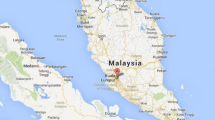Abstract
The settlement curve of the foundation endured the ramp load is an S-type curve, which is usually simulated via Poisson curve. Aimed at the difficulty of preferences in Poisson curve, an immune algorithm (IA) is used. IA is able to obtain a multiple quasi-optimum solution while maintaining the population diversity. In this paper, IA is used in an attempt to obtain accurate settlement prediction. The predicted settlements obtained by IA are compared with those predicted by the least squares fitting method (LSM), the Asaoka method and the genetic algorithm (GA). The results show that IA is a useful technique for predicting the settlement of foundations with an acceptable degree of accuracy and has much better performance than GA and the Asaoka methods.
Similar content being viewed by others
References
Asaoka, A., 1978. Observational procedure of settlement prediction. Soils & Foundation, 18(4):87–101.
Bersini, H., Varela, F.J., 1991. The Immune Recruitment Mechanism: A Selective Evolutionary Strategy. Proceedings of 4th International Conference on Genetic Algorithms, p.520–526.
Burnet, F.M., 1959. The Clonal Selection Theory of Acquired Immunity. Cambridge University Press.
Burnet, F.M., 1978. Clonal Selection and After. In: Bell, G.I., Perelson, A.S., Pimbley, G.H. (Eds.), Theoretical Immunology. Marcel Dekker Inc., New York, p.63–85.
de Castro, L.N., von Zuben, F.J., 2000. The Clonal Selection Algorithm with Engineering Applications. Proceedings of GECCO, Workshop on Artificial Immune Systems and Their Applications. Las Vegas, USA, p.36–39.
Duncan, J.M., 1993. Limitations of conventional analysis of consolidation settlement. Journal of Geotechnical Engineering, 119(9):1333–1359. [doi:10.1061/(ASCE)0733-9410(1993)119:9(1333)]
Farmer, J.D., Packard, N.H., Perelson, A.S., 1986. The immune system adaptation, and machine learning. Physica D: Nonlinear Phenomena, 22(1–3):187–204. [doi:10.1016/0167-2789(86)90240-X]
Jerne, N.K., 1973. The immune system. Scientific American, 229(2):52–60.
Luh, G.G., Chueh, C.H., 2004a. Multi-objective optimal design of truss structure with immune algorithm. Computers and Structures, 82(11–12):829–844. [doi:10.1016/j.compstruc.2004.03.003]
Luh, G.G., Chueh, C.H., 2004b. Multi-topological optimization of structure using immune algorithm. Computer Methods in Applied Mechanics and Engineering, 193(36–38):4035–4055. [doi 10.1016/j.cma.2004.02.013]
Mei, G.X., Zai, J.M., Yin, Z.Z., 2005. Proof of settlement-time curve appearing “S” shape with ramp load and its application based on stress-strain relationship. Rock and Soil Mechanics, 26(5):21–24 (in Chinese).
Miyamoto, A., Nakamura, H., Kruszka, L., 2004. Application of the improved immune algorithm to structural design support system. Journal of Structural Engineering, 130(1):108–119. [doi:10.1061/(ASCE)0733-9445(2004)130:1(108)]
Mori, K., Tsukiyama, M., Fukuda, T., 1993. Immune Algorithm with Searching Diversity and Its Application to Resource Allocation Problem. Transactions-Institute of Electrical Engineers of Japan C, 113(10):872–878.
Olson, R.E., 1998. Settlement of embankments on soft clays. Journal of Geotechnical and Geoenvironmental Engineering, 124(4):278–288. [doi:10.1061/(ASCE)1090-0241(1998)124:4(278)]
Poulos, H.G., 1999. Common Procedures for foundation Settlement Analysis—Are They Adequate? Proc. 8th Australia New Zealand Conf. on Geomechanics, Hobart, Australia, p.3–25.
Rajasekaran, S., Lavanya, S., 2007. Hybridization of genetic algorithm with immune system for optimization problems in structural engineering. Structural and Multidisciplinary Optimization, 34(5):415–429. [doi:10.1007/s00158-006-0084-0]
Tu, X.H., Wang, Z.L., Liang, Z.M., 2005. Study on application of modified Weibull model to settlement prediction of foundation. Rock and Soil Mechanics, 26(4):621–623 (in Chinese).
Yin, Z.Y., 2002. Study on the fitting methods of logistic curve. Application of Statistics and Management, 21(1):41–46 (in Chinese).
Zai, J.M., Mei, G.X., 2000. Growth curve application to forecast the setting of foundation. Journal of Nanjing Architectural and Civil Engineering Institute, 2:8–13 (in Chinese).
Zhang, L.H., Cai, M.F., Niu, Q.L., 2006. Weibull model for prediction the deformation of the complete process of settlement of composite foundation. Industrial Construction, 36(10):54–56 (in Chinese).
Zheng, J.J, Guo, J., 2007. Immune algorithm for reliability analysis of geotechnical engineering. Chinese Journal of Geotechnical Engineering, 29(5):785–788 (in Chinese).
Author information
Authors and Affiliations
Corresponding author
Additional information
Project (No. NCET-06-0649) supported by the New Century Excellent Talents in University, China
Rights and permissions
About this article
Cite this article
Guo, J., Zheng, Jj. & Liu, Y. Application of an immune algorithm to settlement prediction. J. Zhejiang Univ. Sci. A 10, 93–100 (2009). https://doi.org/10.1631/jzus.A0820289
Received:
Accepted:
Published:
Issue Date:
DOI: https://doi.org/10.1631/jzus.A0820289




